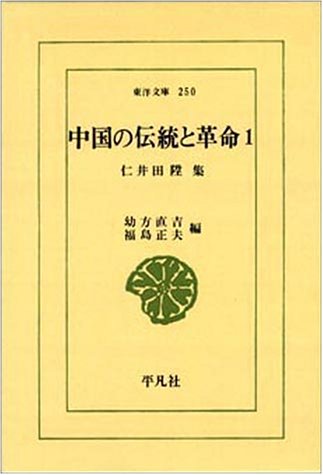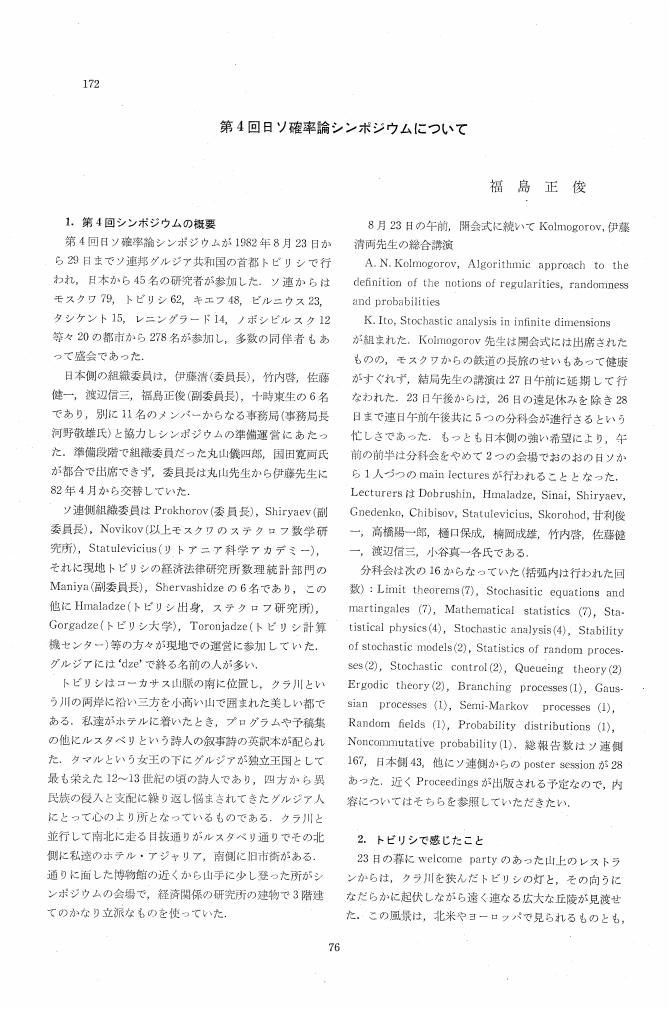2 0 0 0 電弱対称性の破れのダイナミクスと、その宇宙論への応用
研究代表者の吉村は、宇宙論と素粒子物理の接点で焦眉の課題である、物質・反物質不均衡の問題をレプトジェネシス理論で解決するときの諸問題を整理して、今後、実験で解明すべき研究を明らかにするとともに、新たな実験原理を提唱した。特に、励起準安定原子のニュートリノ対生成のレーザー増幅過程が、ニュートリノ質量のマヨラナ性の確定と質量絶対値、混合角度の精密測定に有用であることを指摘して、大きな世界的反響を得た。諸井は、超対称模型に基づく宇宙進化のシナリオに関する研究を行なった。特に、宇宙初期に作られるグラビティーノが宇宙初期元素合成に与える影響を調べ、インフレーション後の宇宙再加熱温度の上限を求めた。この仕事は、関連する一連の研究の決定打として世界的に高い評価を得ている。久野は、超対称模型における暗黒物質探索のための理論研究を行なった。特に、暗黒物質と原子核との散乱断面積、暗黒物質の対消滅過程における量子補正の効果の評価を行なった。棚橋は、TeVスケールコンパクト化された余剰次元模型における電弱対称性の破れ(素粒子質量の起源)のメカニズムを考察し、いくつかの素粒子標準模型を超える模型を提唱した。また、これらの模型に対する現象論的制限を求めた。
2 0 0 0 IR 青年小野梓の家族制度論--「羅瑪律要」纂訳附註を通じて
- 著者
- 福島 正夫
- 出版者
- 早稲田大学法学会
- 雑誌
- 早稲田法学 (ISSN:03890546)
- 巻号頁・発行日
- vol.49, no.1, pp.55-106, 1973-11
2 0 0 0 OA 青年小野梓の家族制度論 ー『羅瑪律要』纂訳附註を通じてー
- 著者
- 福島 正夫
- 出版者
- 早稲田大学法学会
- 雑誌
- 早稲田法学 (ISSN:03890546)
- 巻号頁・発行日
- vol.49, no.1, pp.55-106, 1973-11-01
1 0 0 0 OA オフロキサシン点耳液の効果 (耳浴時間による検討)
- 著者
- 蓑田 涼生 宇野 研吾 福島 正人 土生 健二郎 杉 宣宏 石川 哮
- 出版者
- 耳鼻と臨床会
- 雑誌
- 耳鼻と臨床 (ISSN:04477227)
- 巻号頁・発行日
- vol.40, no.5, pp.780-786, 1994-09-20 (Released:2013-05-10)
- 参考文献数
- 12
オフロキサシン (以下OFLX) はグラム陽性菌, グラム陰性菌に広い抗菌力が認められているキノロン系抗菌剤で, 耳用液は各種感染性耳疾患において用いられている. 耳浴時間は従来の耳浴時間にならつて10分間とされているが, 薬剤の性質を考慮すると, 耳浴時間の短縮は充分可能であると思われる. 今回, 従来通りの10分耳浴群と2~3分の短縮耳浴群の2群においての臨床効果について比較検討を行い, その可能性について検討した. その結果2~3分耳浴両群においても10分耳浴と同様に高い臨床効果と安全性を認めた.
1 0 0 0 OA 外熱式ロータリーキルンを使用した容器包装廃プラスチックの熱分解技術の開発
- 著者
- 福島 正明 伊部 英紀 若井 慶治 杉山 英一 安部 裕宣 呉 倍莉 北川 希代彦 鶴賀 重徳 志村 勝美 小野 栄一
- 出版者
- 一般社団法人 廃棄物資源循環学会
- 雑誌
- 廃棄物資源循環学会論文誌 (ISSN:18835856)
- 巻号頁・発行日
- vol.22, no.2, pp.114-126, 2011 (Released:2011-05-11)
- 参考文献数
- 16
- 被引用文献数
- 1 1
PVCとPETを含む容器包装混合廃プラスチック油化処理技術において,外熱式ロータリーキルンを使用した熱分解装置の開発を行い,下記の結果を得た。(1)PVCとPETを含む混合廃プラスチックの熱分解油収率は,3P(PE, PP, PS) の熱分解油収率に比べて約20~30wt%低く,熱分解残渣は約20wt%高い。(2)ロータリーキルンは,連続処理運転よりもセミバッチ処理運転 (脱塩後の溶融プラ投入を一時停止し熱分解・残渣排出) が熱分解油の収率が高い。(3)脱塩素プロセスと熱分解プロセスを分離し,脱塩素と熱分解の同時並行処理を行い,熱分解の効率化を図ることができた。(4)脱塩素から熱分解まで装置を垂直に配置し,ポンプ等の移送設備を使用しない重力移送方式を採用し,溶融プラの流動性悪化に起因したトラブル発生を防止することができた。(5)廃プラ熱分解油は石油化学原料化が可能であることが明らかとなり,フィードストックリサイクルの対象油を軽質油から分解油に広げることが可能となった。
1 0 0 0 OA 血液濾過透析を含めた集学的治療により肝性脳症が管理できた維持血液透析患者の1例
- 著者
- 西川 真那 島田 典明 永山 泉 福島 和彦 天野 圭慧子 川北 智英子 澤田 真理子 木野村 賢 福島 正樹 浅野 健一郎
- 出版者
- 一般社団法人 日本透析医学会
- 雑誌
- 日本透析医学会雑誌 (ISSN:13403451)
- 巻号頁・発行日
- vol.48, no.3, pp.199-205, 2015 (Released:2015-03-27)
- 参考文献数
- 26
- 被引用文献数
- 1 1
57歳男性, 透析歴35年. C型肝硬変があり週初めの血液透析 (HD) 後にのみ肝性脳症Ⅲ度を繰り返した. 低カリウム血症などの誘因はなく, 分岐鎖アミノ酸製剤とラクツロース, レボカルニチンを追加し透析液の重炭酸濃度を低減した. しかし再び週初めのHD後に肝性脳症Ⅲ度となり血漿アンモニア濃度は219μg/dLであった. CTで太い門脈-大循環シャントを認め, ドップラー超音波で測定した門脈血流はHD後に低下していた. 血液濾過透析 (HDF) への変更で門脈血流の低下を減少でき, カナマイシンも追加し以後の肝性脳症はみられていない. 肝性脳症の原因にはアンモニアなどの代謝異常に加え, 門脈血の大循環への流入がある. HDにより大循環の圧が低下することで, 門脈-大循環シャントを介した門脈血の大循環への流入量が増えHD後の肝性脳症を惹起するとされる. HDFによる門脈血流の保持を含めた集学的治療で肝性脳症の再発を抑制できた.
1 0 0 0 OA リンゴ果汁の熱物性
- 著者
- 村松 良樹 田川 彰男 笠井 孝正 境 博成 福島 正義
- 出版者
- 公益社団法人 日本食品科学工学会
- 雑誌
- 日本食品科学工学会誌 (ISSN:1341027X)
- 巻号頁・発行日
- vol.47, no.7, pp.548-550, 2000-07-15 (Released:2009-02-19)
- 参考文献数
- 10
- 被引用文献数
- 3 5
10∼45%(w/w)の固形分濃度に調整したリンゴ果汁の熱物性を10∼50°Cの温度範囲で測定した.その結果,熱伝導率,温度伝導率は温度について一次式,また濃度に関しては二次式とした実験式でそれぞれ表すことができた.また,比熱については,温度,濃度双方に関して一次式とした実験式を得た.
- 著者
- 福島 正明 伊部 英紀 若井 慶治 杉山 英一 安部 裕宣 呉 倍莉 北川 希代彦 鶴賀 重徳 志村 勝美 小野 栄一
- 出版者
- 一般社団法人 廃棄物資源循環学会
- 雑誌
- 廃棄物資源循環学会論文誌 = Journal of the Japan Society of Material Cycles and Waste Management (ISSN:18835856)
- 巻号頁・発行日
- vol.22, no.3, pp.178-189, 2011-05-31
- 参考文献数
- 19
- 被引用文献数
- 2
一般市民から資源ごみとして出される使用済みプラスチック製容器包装の熱分解油化技術において,ポリ塩化ビニル (PVC) 等の塩素含有プラスチックの熱分解によって脱離する塩素の効率的処理が,再生製品の品質改善の課題となっている。本研究では二軸押出機方式による脱塩素の滞留時間が短いことに着目し,一軸押出機を使用した脱塩装置の開発を行い,一軸押出機は二軸押出機と同様に脱塩素率が高く,脱塩素時間 (滞留時間) も短いという結果を得た。<BR>本実験結果を基に10倍にスケールアップした一軸押出機 (脱塩装置) を使用した商用熱分解油化プラントを2000年北海道札幌市東区中沼町に建設し,2009年度で運転10年目を迎えている。使用済みプラスチック製容器包装油化リサイクルにおける脱塩素技術の開発成果を報告する。
1 0 0 0 中国の伝統と革命 : 仁井田陞集
- 著者
- 仁井田陞著 幼方直吉 福島正夫編
- 出版者
- 平凡社
- 巻号頁・発行日
- 1974
1 0 0 0 OA 知的障害児の主体性形成の視点からの特別児童扶養手当制度(1) (守弘仁志教授 追悼号)
- 著者
- 福島 正剛
- 出版者
- 熊本学園大学社会関係学会『社会関係研究』編集委員会
- 雑誌
- 社会関係研究 = The study of social relations (ISSN:13410237)
- 巻号頁・発行日
- vol.26, no.1, pp.19-43, 2020-11-30
1 0 0 0 『史通』と『資治通鑑』
- 著者
- 福島 正
- 出版者
- 京都大学文学部 中国哲学史研究会
- 雑誌
- 中国思想史研究 = JOURNAL of HISTORY OF CHINESE THOUGHT (ISSN:03883086)
- 巻号頁・発行日
- vol.18, pp.1-39, 1995-12-25
1 0 0 0 『論衡』と『史通』
- 著者
- 福島 正
- 出版者
- 京都大学文学部 中国哲学史研究会
- 雑誌
- 中国思想史研究 = JOURNAL of HISTORY OF CHINESE THOUGHT (ISSN:03883086)
- 巻号頁・発行日
- vol.26, pp.26-66, 2003-12-25
1 0 0 0 OA ハナグモの生活史および習性
- 著者
- 福島 正三 宮藤 守雄
- 出版者
- 北日本病害虫研究会
- 雑誌
- 北日本病害虫研究会報 (ISSN:0368623X)
- 巻号頁・発行日
- vol.1970, no.21, pp.5-12, 1970-11-20 (Released:2011-08-11)
- 参考文献数
- 18
Ten years ago, about 40 species of spiders were recorded from the apple or chard by the senior author, while engaged in a study of the effects of spray programs on pest population and beneficial organisms (HUKUSIMA, 1961). Of these collections Misumenops tricuspidatuswas considered first as an important predator of orchard pests, because of its universal occurrence and frequent abundance. But almost nothing is known of the bionomics of this species up to date. From an economic side, at present, the first thing to do in analysing the property of the hunting spider as regulating agents in orchards is to know some aspects of life histories and habits.Based on the field survey, M. tricuspidatus hibernates in various instars of nymphal period and adult stage from November among the ground cover of fallen leaves and dead herbaceous plants, but adults or larger immature stages are the most case which is frequently observed during winter in orchards. As the season advanced, overwintered adults and immatures leave their hibernation qua ters on warm days in following early March, and rest on the trunks and branches of fruit tree. Meanwhile, the peaks of seasonal occurrences were formed over 3 times, on mid-April, early July early August and mid-October.According to the observations in a insectary, the mating takes place mostly in the daytime without food intake except particular case. At the time of oviposition, the female builds a crude nest by tying two or more overlapping leaves together and constructs the lenticular egg-sac within it. Thus the 1st egg-sacs were produced on late May early July, and next during the period from late August to early October. In this case, the number of eggs per egg-sac varied with different seasons, and an average of 163.1 and 87.7 eggs per egg-sac was counted corresponding with above seasons respectively.M. tricuspidatus mostly feed on living organisms like other spider species, but under the fasting condition they sometimes utilize the dead arthropods. Such a habit would servefor the recovery from exhaustion by hunger. In contrast to male behavior, the feeding activity of females does not become weak after they reached adulthood, but 7 times of male meal per day were consumed when prey was supplied in suitable number. The daily food consumption of immature stages, as a rule, increases keenly about 2 days after moulting, and also adult females tend to increase their foods just after the final moulting and mating.With regard to the number of moults, all individuals reared did not moult in the same number, but they moulted 5 to 9 times after leaving the egg-sac. In this context, it is well known fact that the number of moults necessary for maturity in many species of spiders is somewhat variable, and may be increased under unfavorable conditions. This assumption would seem easily to admit in the present case. Namely the phenomenon that the number of moults in M. tricuspidatus increases under the lower rearing temperature and with the decrease of food supply, was clearly evidenced. Further this tendency strongly appeared in the females than in the males.Already as a few case was mentioned, a considerable variation of life histories and habits under different temperature conditions is thought to be worthy of notice. As might be expected, within 25-30°C the duration of each instar shortened with increasing temperature, and at the same time much more foods were consumed at higher temperature condition, though the feeding intensity was not necessarily indicated in the same pattern between males and females. On the other hand, the number of egg-sacs per female was somewhat more under 25°C, and the rate of hatching was also higher than that under 30°C.
1 0 0 0 OA 第5回日ソ確率論シンポジウムについて
- 著者
- 福島 正俊
- 出版者
- 一般社団法人 日本数学会
- 雑誌
- 数学 (ISSN:0039470X)
- 巻号頁・発行日
- vol.39, no.3, pp.264-267, 1987-07-30 (Released:2008-12-25)
1 0 0 0 OA 第4回日ソ確率論シンポジウムについて
- 著者
- 福島 正俊
- 出版者
- 一般社団法人 日本数学会
- 雑誌
- 数学 (ISSN:0039470X)
- 巻号頁・発行日
- vol.35, no.2, pp.172-175, 1983-04-26 (Released:2008-12-25)
1 0 0 0 公開討論 (特集 シンポジウム 公文書と地域資料の保全)
1 0 0 0 OA 加齢に伴うエナメル質亀裂の発生原因の究明および予防と治療対策の確立
本研究は,エナメル亀裂の発生頻度や臨床症状にっいて調査を行った.その結果として:1.亀裂検出率は年齢増加と共に上昇傾向を示し50代以後では100%の被験歯に亀裂が認めた.2.10~30代の被験者では,修復歯は非修復歯と比較して亀裂検出率が高い傾向を示した.3.加齢に伴って亀裂の着色により肉眼で容易に確認可能できる亀裂の割合が増加した.4.冷刺激による誘発痛は,20-60代の被験者において亀裂歯の13-16.7%に認められた.5.噛み合わせ指導、う蝕予防、口腔衛生指導、低稠度樹脂性材料による亀裂の封鎖などは、亀裂の予防対策あるいは早期治療方法として有効である。
1 0 0 0 高マグネシウム血症により意識障害をきたした慢性腎不全の2例
- 著者
- 中司 敦子 神崎 資子 高木 章乃夫 岩田 康義 池田 弘 福島 正樹
- 出版者
- 一般社団法人 日本透析医学会
- 雑誌
- 日本透析医学会雑誌 (ISSN:13403451)
- 巻号頁・発行日
- vol.37, no.2, pp.163-168, 2004
- 被引用文献数
- 2
慢性腎不全患者の意識障害として尿毒症性脳症が知られているが, 透析療法が普及した昨今ではこの病態を経験することはまれである. 今回われわれは緩下剤の連用中に高マグネシウム (Mg) 血症による意識障害をきたした慢性腎不全の2症例を経験したので報告する.<br>症例1は77歳, 男性. 糖尿病性腎症による慢性腎不全で加療中, 食欲不振と意識混濁が出現し入院. 血清Cr 4.31mg/dL, BUN 64mg/dL, 血清Mg 7.3mg/dLと上昇. 血清カルシウム値は5.8mg/dLと低下. 皮膚の潮紅, 肺炎および呼吸抑制による呼吸不全を認めた. 血液透析で血清Mg値は低下したが, 翌日再分布によると考えられる再上昇をきたしたため血液透析を再度行い軽快した.<br>症例2は78歳, 女性. 慢性関節リウマチ, 腎機能低下で加療中に尿路感染症により腎機能が増悪し, 全身倦怠感, 見当識障害が出現したため入院. 血清Cr 6.56mg/dL, BUN 96mg/dL, 血清Mg 7.1mg/dLと上昇. 血液透析を3日間連続して行い軽快した.<br>いずれの症例もMg製剤の服用歴を有し, 高度な高窒素血症が存在しないにもかかわらず意識障害を呈した. 当院で2年間に血液透析導入時に血清Mgを測定した78例中, 中毒域の高Mg血症をきたしたのは今回提示した2例のみであった. その他に, 意識障害をきたした症例は低血糖の1例のみで, 尿毒症性脳症による意識障害はなかった. 今回の症例では緩下剤の連用および感染による慢性腎不全の急性増悪が重篤な高Mg血症の原因と考えられた. 治療として血液透析が有効であったが, 再分布による血清Mg値の再上昇に注意が必要である.
1 0 0 0 OA 市販缶ビール中のアルミニウム溶存量について
- 著者
- 福島 正子 小林 拓美 竹山 恵美子 早川 保昌
- 出版者
- Japanese Society for Food Science and Technology
- 雑誌
- 日本食品工業学会誌 (ISSN:00290394)
- 巻号頁・発行日
- vol.37, no.9, pp.682-686, 1990-09-15 (Released:2009-04-21)
- 参考文献数
- 9
- 被引用文献数
- 1 1
弱酸性食品であるビールに金属アルミニウムが長時間接触した場合,食品がどのような影響を受けるか,その腐食傾向と食品中のアルミニウム溶存量を測定することにより検討した.まずビールによる金属アルミニウムの腐食傾向を自然電極電位の経時変化及び分極曲線で測定したところ,ビールはアルミニウムを局部腐食より全面腐食しやすいということがわかった.次に市販ビール中に溶存するアルミニウムを原子吸光分光光度計で定量した場合,缶からビール中にアルミニウムが溶出することがわかった.その際溶出量は3ケ月以上の室温保存で有意に増加することが認あられた.また5℃で保存したものより室温保存した市販缶ビールの方がアルミニウム溶存値は高いという結果が得られた.
- 著者
- 福島 正樹
- 出版者
- 信濃史学会
- 雑誌
- 信濃 [第3次] (ISSN:02886987)
- 巻号頁・発行日
- vol.73, no.4, pp.249-280, 2021-04


